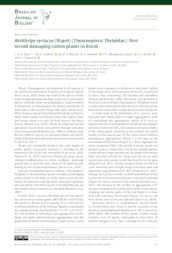Retithrips syriacus (Mayet) (Thysanoptera: Thripidae): first record damaging cotton plants in Brazil.
Retithrips syriacus (Mayet) (Thysanoptera: Thripidae): first record damaging cotton plants in Brazil.
Author(s): SILVA, C. A. D. da; CAVALIERI, A.; MORAIS, M. M. D.; ANDRADE, W. L.; ALBUQUERQUE JÚNIOR, P. S.; SERRÃO, J. E.; ZANÚNCIO, J. C.
Summary: Thrips (Thysanoptera) are dispersed in all regions of the world, but with higher frequency in tropical regions (Kerns et al., 2019). More than half of the species of this order are phytophagous feeding on only one or a few plant species although some are polyphagous. Approximately 6,300 species of Thysanoptera are known worldwide, of which about 130 are pests (Thrips Wiki, 2022; Mound et al., 2022). Some groups of thrips feed preferentially on flowers, while others prefer exclusively leaves, but pollen, fruits and young shoots can also be food sources for these insects (Mound et al., 2022). Thrips are important for the agriculture due to direct and indirect damage, including virus transmission (Monteiro et al., 1998). In addition, they feed on different species of cultivated plants and weeds, many of them found in the cotton production environment (Cook et al., 2011). Thrips are commonly found at the early stages of cotton plants (Gossypium hirsutum L.) feeding on the epidermal cells of the leaf mesophyll (Kaur et al., 2018; Nadeem et al., 2022). Intensive feeding by thrips causes terminal malformation in cotton seedlings, abnormal growth and, in extreme cases, death of the growing bud, leading to loss of apical dominance (Kerns et al., 2019). In Brazil, Frankliniella schultzei (Trybom) (Thysanoptera: Thripidae) is the main thrips species recorded and damaging cotton plants in the states of Goiás, Mato Grosso do Sul, Paraná, Pernambuco and São Paulo, although Caliothrips phaseoli (Hood) and other species of Frankliniella spp. are also found in lowers numbers on this plant (Monteiro et al., 1998). In April 2022, a severe infestation by a thrips species was observed on cotton plants, BRS 368 RF, with 85 days old, grown in 30 pots with a capacity of 5 L each one in a screened greenhouse at the Embrapa Algodão, municipality de Campina Grande, Paraíba, Brazil (7°13?35? S, 35°54?21? W). The number of individuals and aggregations of this thrips per plant, individuals per aggregations and the proportion of adults and immature stages on ten cotton plants were evaluated on all leaves of each plant. Adults of the thrips were collected from the leaves, transferred to glass vials containing 70% alcohol and identified (Mound and Marullo, 1996). The thrips was identified as Retithrips syriacus Mayet (Thysanoptera: Thripidae) based on specimens deposited in the reference collection of the Federal University of Rio Grande, Rio Grande do Sul, Brazil.
Publication year: 2022
Types of publication: Journal article
Unit: Embrapa Cotton
Keywords: Algodão, Cotton, Disease and pest management, Inseto, Manejo, Peste, Plant damage, Praga de Planta, Thrips, Thysanoptera, Tripes
Observation
Some of Embrapa's publications are published as ePub files. To read them, use or download one of the following free software options to your computer or mobile device. Android: Google Play Books; IOS: iBooks; Windows and Linux: Calibre.
Access other publications
Access the Agricultural Research Database (BDPA) to consult Embrapa's full library collection and records.
Visit Embrapa Bookstore to purchase books and other publications sold by Embrapa.

